Looking to add a touch of elegance and tranquility to your garden or landscape? White flower trees offer timeless beauty and charm, making them popular choices among gardeners and landscapers alike.
In this article, we’ll explore 52 types of white flower trees, complete with pictures and detailed identification, to help you choose the perfect addition to your outdoor space.
Whether you’re seeking delicate blooms for a cottage garden or show-stopping specimens for a formal landscape, you’re sure to find inspiration among these stunning varieties.
Different Types of White Flower Trees
White Flowering Almond Tree

The White Flowering Almond Tree (Prunus glandulosa alboplena) showcases delicate, white flowers in early spring, enhancing its bare branches with an ethereal beauty. Resembling fluffy white clouds, these blossoms create an elegant and serene atmosphere in gardens.
With vibrant green leaves emerging post-bloom, it offers year-round allure. Compact in size, it reaches 6 to 8 ft. tall, suitable for USDA Hardiness Zones 4 to 8, thriving in full sun exposure.
White Flowering Pear tree
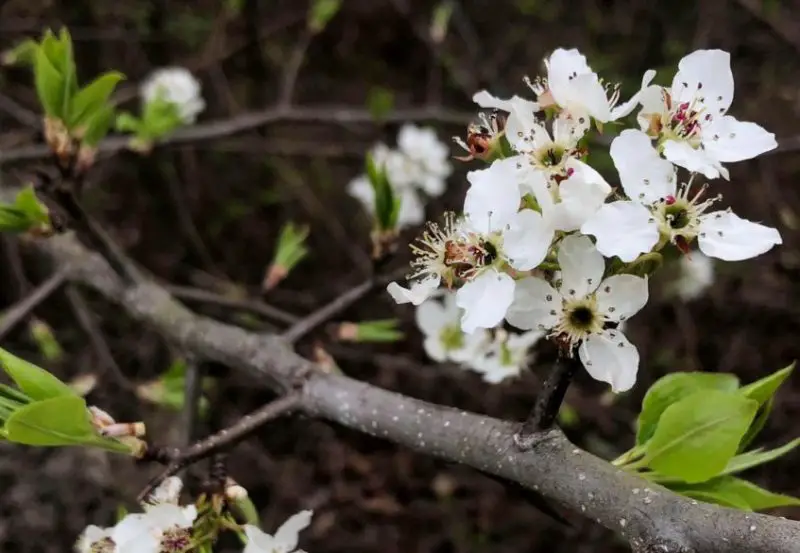
The White Flowering Pear Tree (Pyrus spp.) enchants with creamy-white flower clusters in spring, contrasting elegantly against glossy green leaves. Fall brings a spectacle of yellow, orange, and red foliage.
Adaptable to various soils, it thrives in well-drained conditions. Ideal as specimen or small shade trees, they reach 20 to 30 ft. tall and wide, suitable for USDA Hardiness Zones 6 to 9, requiring full sun exposure.
White Flowering Crabapple Trees
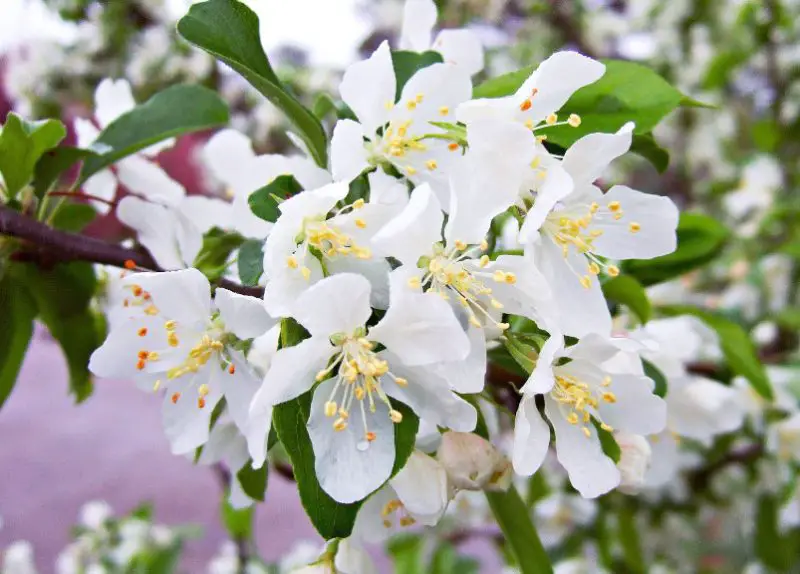
White Flowering Crabapple Trees (Malus spp.) are beloved for their abundant clusters of fragrant white flowers, emerging from pink buds in mid to late spring. These small deciduous trees feature dark green lobed leaves and cherry-like pomes.
With a compact size, they suit smaller landscapes or as accents in larger yards, thriving in USDA Hardiness Zones 5 to 9 with full sun exposure. Varieties include Sargent Crabapple, Lollipop Crabapple, Snowdrift Crabapple, and Siberian Crabapple, each offering unique features and sizes.
Carolina Silverbell Tree
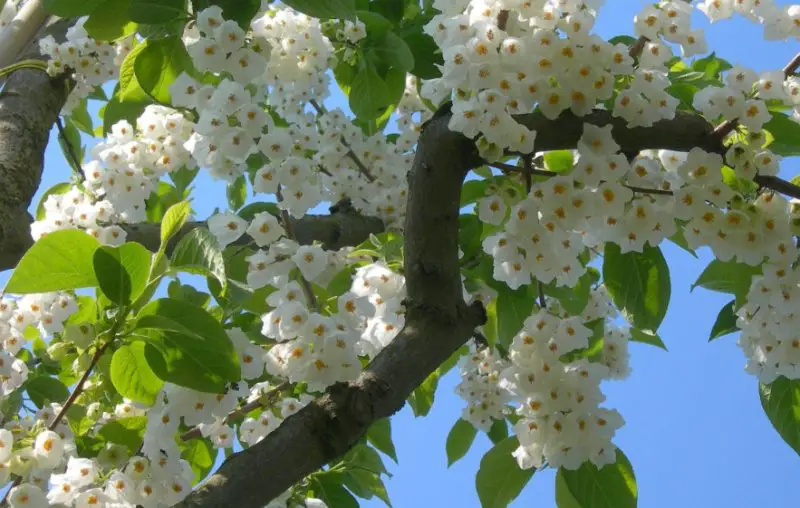
The Carolina Silverbell Tree (Halesia carolina) is recognized by its delicate white bell-shaped flowers, hanging gracefully from branches and blooming early in the season. Fragrant and attractive to pollinators, its vibrant green leaves turn yellow in fall.
Thriving in moist, well-drained soils, it’s ideal as a large ornamental shrub or small tree, perfect for specimen planting or in shrub borders. Reaching 30 to 40 ft. tall and 20 to 35 ft. wide, it suits USDA Hardiness Zones 4 to 8, thriving in partial shade.
Japanese Snowbell
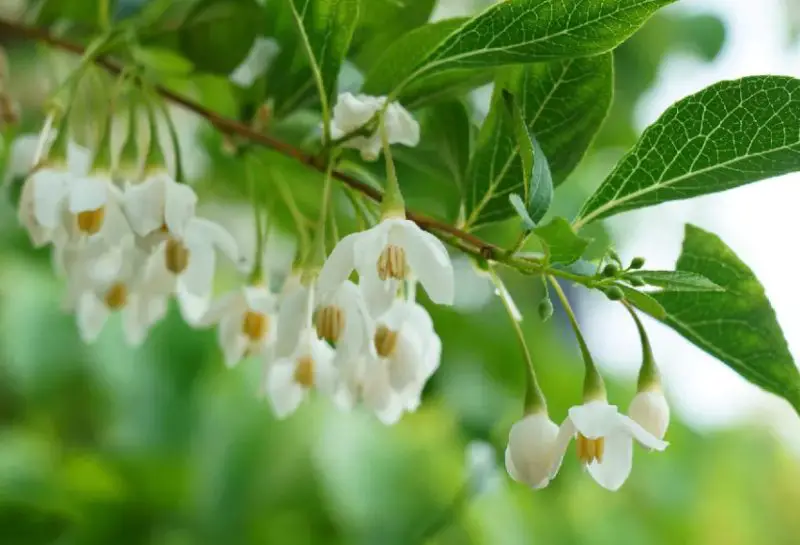
The Japanese Snowbell (Styrax japonicus) showcases delicate bell-shaped white flowers with yellow stamens, exuding a sweet fragrance as they gracefully adorn branches. Its dark green leaves transition to yellow in fall, enhancing its allure.
Preferring acidic, well-drained soils and partial shade, it reaches 20 to 30 ft. tall and wide, thriving in USDA Hardiness Zones 6 to 8. Its attractive peeling bark adds to its attractiveness, making it ideal for woodland gardens or as a specimen tree.
Northern Catalpa Tree
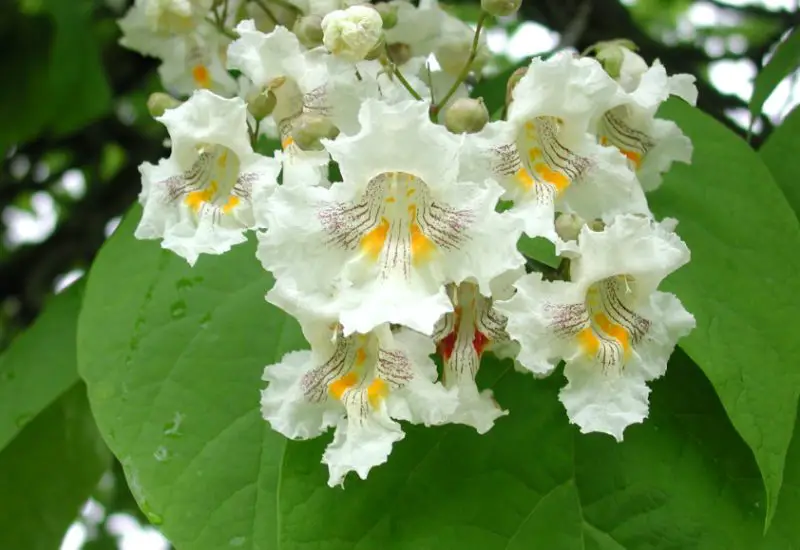
The Northern Catalpa Tree (Catalpa speciosa) stands out with its large heart-shaped leaves and clusters of white, trumpet-shaped flowers adorned with purple speckles and yellow blotches in spring. Followed by long, bean-like seed pods, these flowers give way to vibrant yellow foliage in fall.
Adaptable to various soils, it thrives as a shade or specimen tree in large landscapes, reaching 50 to 70 ft. tall and 20 to 50 ft. wide. Suitable for USDA Hardiness Zones 4 to 8, it prefers full sun to partial shade.
Horse Chestnut
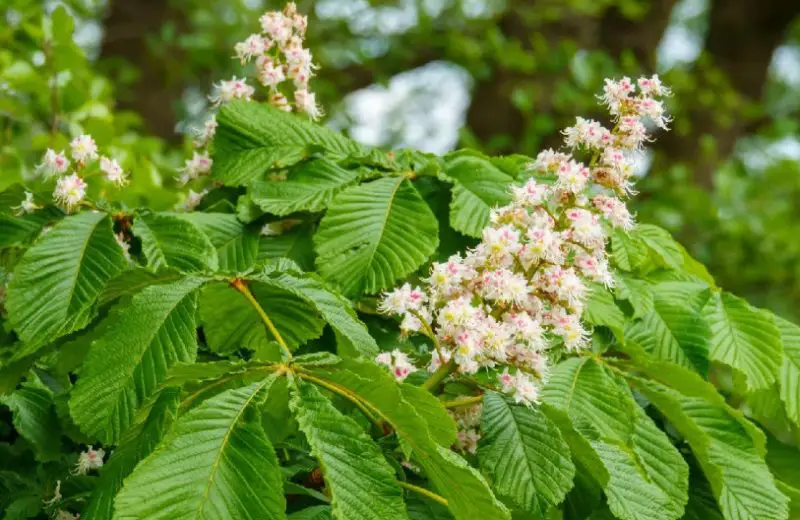
The Horse Chestnut (Aesculus hippocastanum) is distinguished by its upright cone-like clusters of showy white flowers and large, distinctive leaves. Blooming in late spring, its pinkish-white flowers form 12″ tall conical clusters.
With palmately compound leaves turning yellow or orange, it’s low-maintenance, ideal for shade or ornamental use in large landscapes. Its large spiny capsules encase shiny brown nuts. Reaching 50 to 75 ft. tall and wide, it suits USDA Hardiness Zones 3 to 8, thriving in full sun or partial shade.
Ohio Buckeye Tree
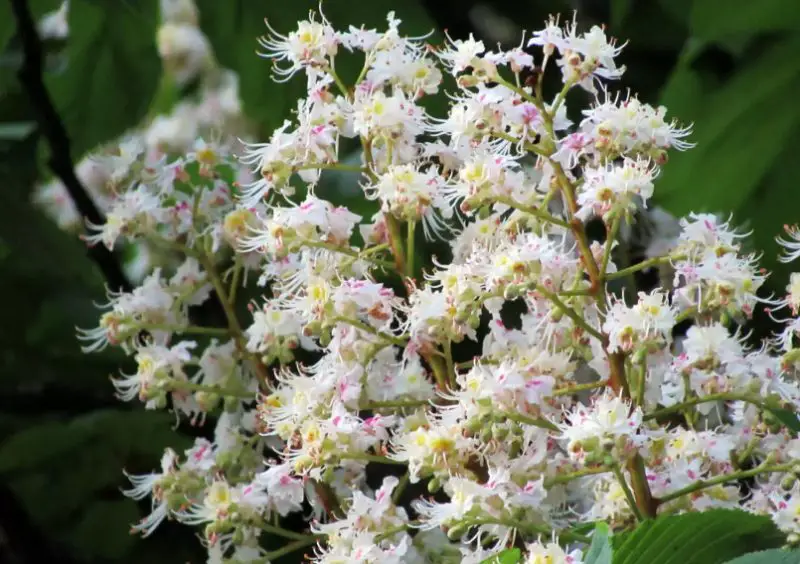
The Ohio Buckeye Tree (Aesculus glabra) is recognized for its showy white flowers and distinctive fruit resembling a buck’s eye. Producing conical clusters of white, tubular flowers in spring, it yields round, spiky fruit capsules containing shiny brown nuts.
Ideal for well-drained, moist soil, it provides shade and attractive spring flowers in USDA Hardiness Zones 3 to 7, reaching 20 to 40 ft. tall and wide in full sun or partial shade.
White Fringe Tree
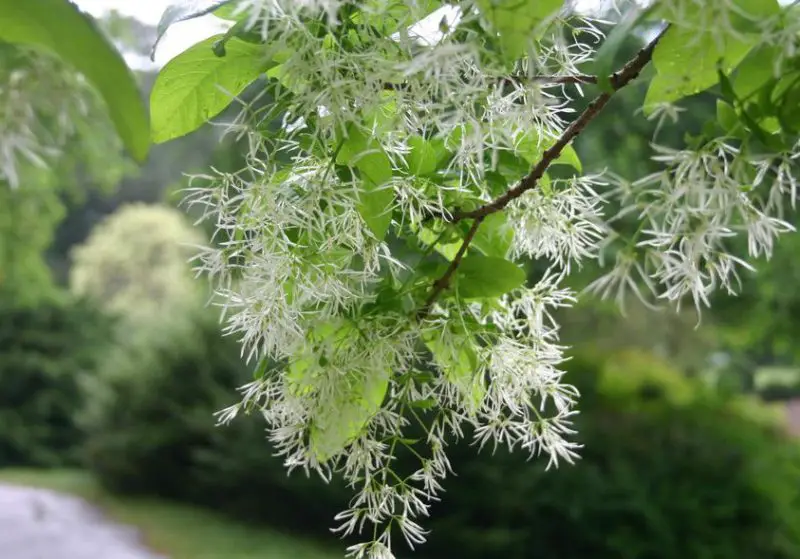
The White Fringe Tree (Chionanthus virginicus), native to the eastern United States, showcases masses of cream-white fragrant flowers with fringe-like, wiry petals in spring. Its lanceolate leaves turn yellow in fall, and it bears clusters of dark blue summer fruits.
Adaptable to various soils, it thrives in USDA Hardiness Zones 3 to 9, reaching 12 to 20 ft. tall and wide. It prefers full sun to partial shade and suits mixed borders, specimen planting, or group displays.
Flowering Dogwood
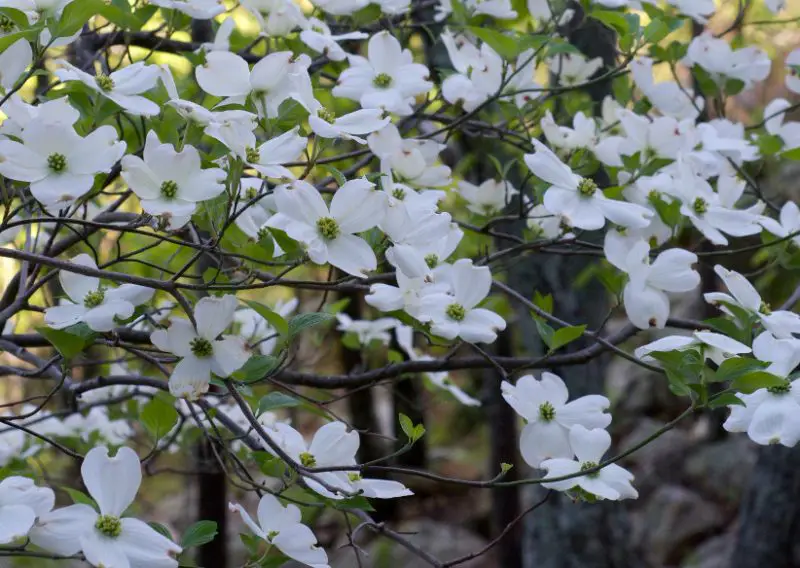
The Flowering Dogwood (Cornus florida) is renowned for its stunning white bract-like flowers, large star-shaped blooms, and vibrant fall colors. With bright red summer berries and distinctive bark resembling alligator skin, it offers year-round interest.
Thriving in well-drained, acidic soil and partial shade, it suits woodland gardens or as an ornamental tree near patios or lawns. Reaching 15 to 30 ft. tall and wide, it’s ideal for USDA Hardiness Zones 5 to 9.
Giant Dogwood
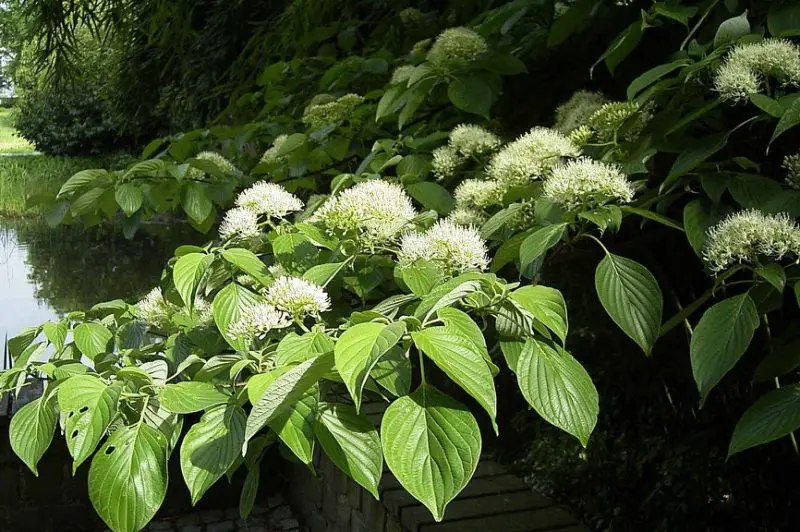
The Giant Dogwood (Cornus controversa) is distinguished by its masses of creamy-white flowers, green or variegated leaves, and black berries. Its layered horizontal branches earned it the name “wedding cake tree.”
Thriving in organically fertile, acidic, well-drained soil, it’s ideal as a focal point or specimen tree in small to medium-sized gardens. Growing 30 to 40 ft. tall and wide, it suits USDA Hardiness Zones 5 to 8, thriving in partial shade to full sun.
Tea Plant
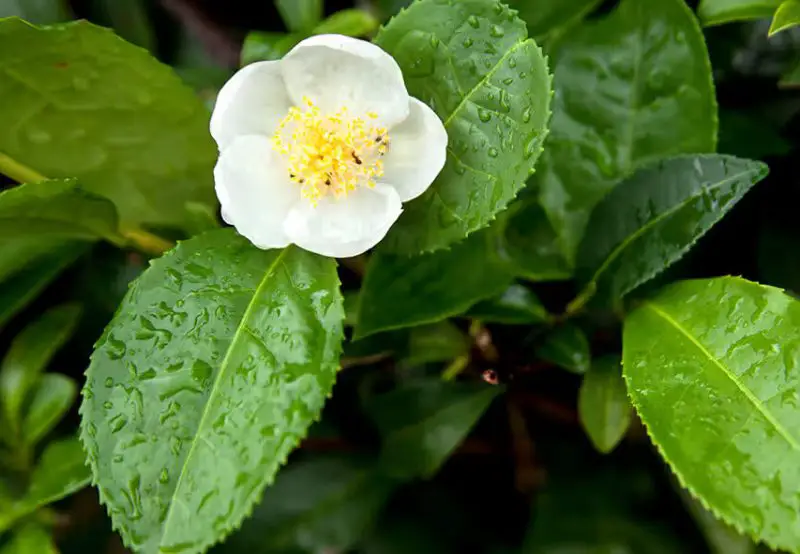
The Tea Plant (Camellia sinensis) is an evergreen shrub or small tree prized for its aromatic tea leaves. While its small white flowers with yellow centers are not its main attraction, they complement its glossy green leaves.
Thriving in acidic, well-drained soil and partial shade, it’s ideal for temperate climates, reaching 10 to 15 ft. tall and 6 to 10 ft. wide in USDA Hardiness Zones 7 to 9.
Japanese Lilac Tree
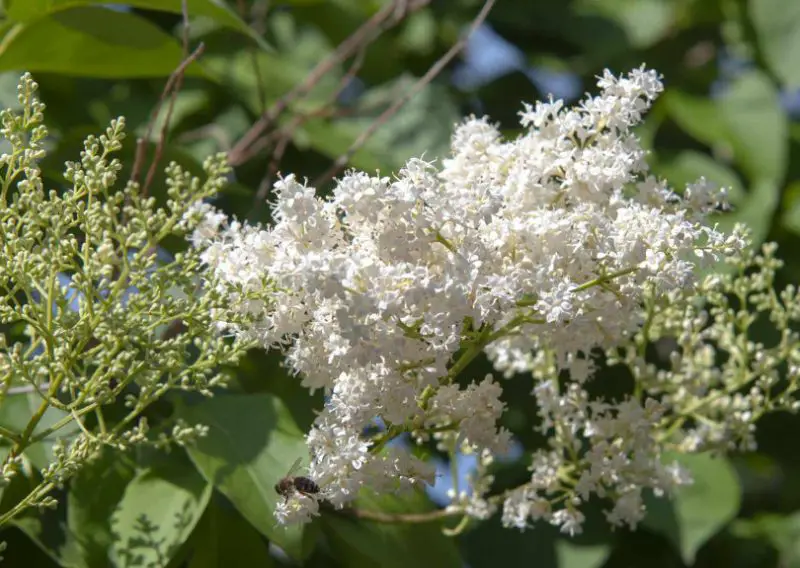
The Japanese Lilac Tree (Syringa reticulata) is a deciduous tree prized for its clusters of fragrant, creamy-white flowers. With reddish-brown peeling bark and sharply-tipped dark green leaves, it blooms in early summer, creating a stunning display.
Adaptable to various soils, it’s low-maintenance and suitable for foundation plantings, specimen trees, or landscaping in USDA Hardiness Zones 3 to 7. Reaching 20 to 30 ft. tall and 15 to 25 ft. wide, it thrives in full sun to partial shade.
American Elderberry
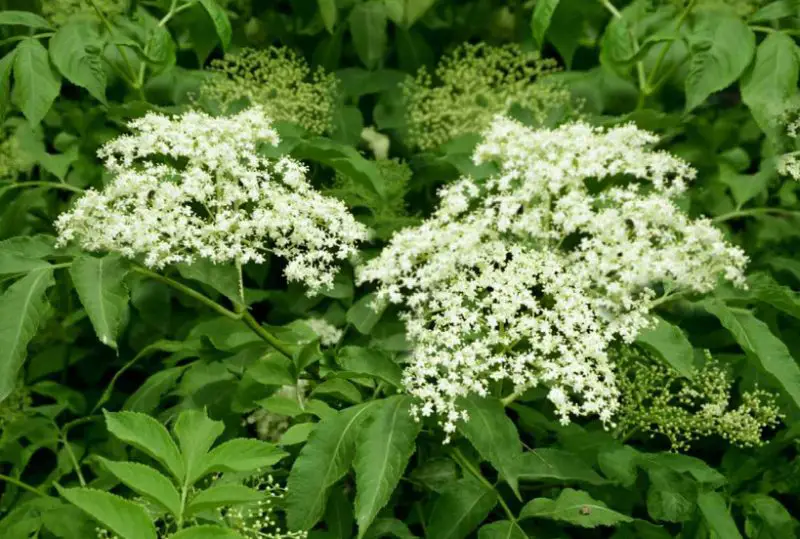
The American Elderberry (Sambucus canadensis) is a deciduous shrub or small tree adorned with clusters of small, lemon-scented white flowers in spring. Contrasting with lance-shaped green leaves, it yields glossy edible black berries after flowering.
Thriving in wetland areas, it’s ideal for USDA Hardiness Zones 3 to 9, reaching 5 to 12 ft. tall and wide. It enjoys full sun to partial shade and attracts pollinators and wildlife.
Whitebeam
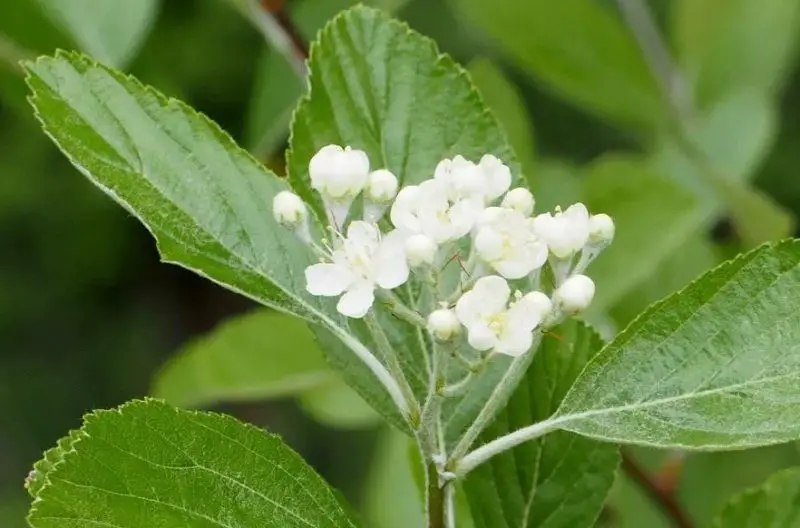
The Whitebeam (Sorbus aria) is a deciduous tree known for its silvery, fuzzy underside leaves, clusters of white spring flowers, and small red fall berries. With oval-shaped leaves, its silvery-white underside lends it its name.
Thriving in various soils, it’s ideal for USDA Hardiness Zones 4 to 7, reaching 25 to 30 ft. tall and up to 25 ft. wide. It enjoys full sun to partial shade and serves as an ornamental, wildlife-friendly addition to landscapes.
Swedish Whitebeam
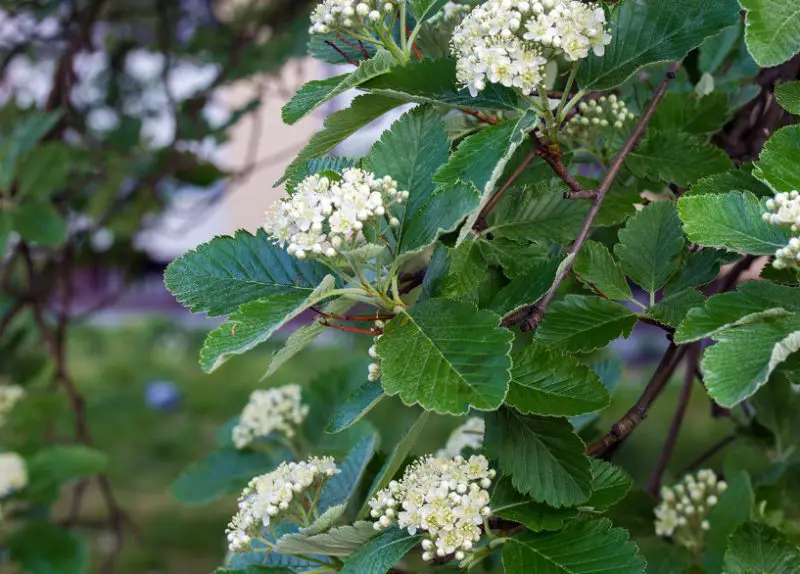
The Swedish Whitebeam (Sorbus intermedia) is a Northern European native with deeply-lobed dark green leaves and dense clusters of brilliant white flowers. Bearing bright red berries, it features a rounded crown and yellow fall foliage.
Hardy and adaptable, it thrives in USDA Hardiness Zones 5 to 8, reaching 30 to 40 ft. tall and wide. It tolerates urban and coastal conditions, making it ideal for city or coastal planting, and serves well as a shade tree in large landscapes.
Devilwood
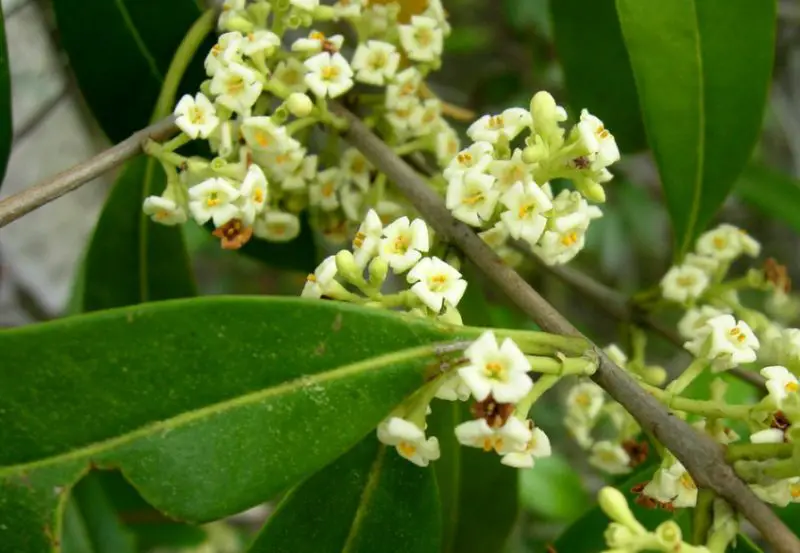
The Devilwood (Cartrema americanus), or American olive, is a small evergreen tree with fragrant white flowers native to the southeastern United States. It features wavy-edged green leaves and dark blue drupes.
Thriving in moist, well-drained soils, it’s ideal for USDA Hardiness Zones 6 to 9, reaching 10 to 30 ft. tall and wide. It enjoys full sun to deep shade and serves as an excellent specimen plant or barrier in small gardens.
Black Locust
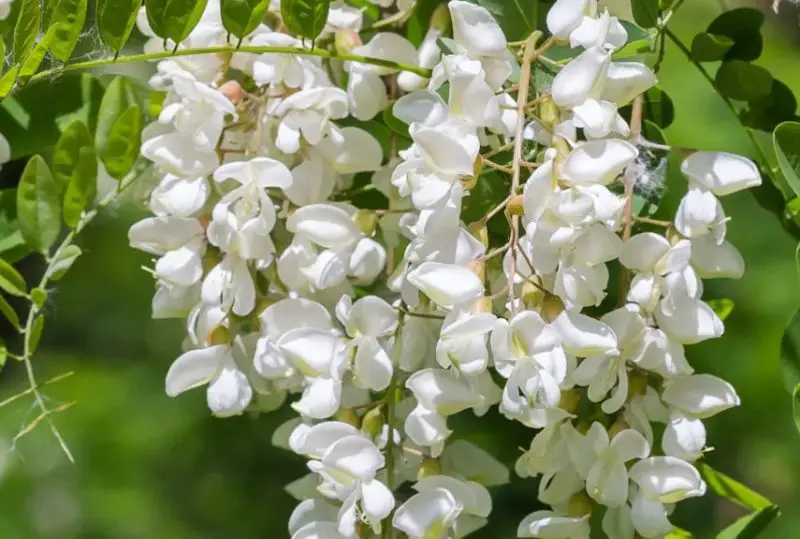
The Black Locust (Robinia pseudoacacia) is a deciduous tree recognized by its thorny bark and fragrant, white spring flowers. Dangling from black branches, its pea-like clusters adorn the tree.
With bright green compound leaves, it grows rapidly in dry to medium soils in USDA Hardiness Zones 4 to 9, reaching 30 to 50 ft. tall and wide. It thrives with at least six hours of daily sunshine.
Allegheny Serviceberry
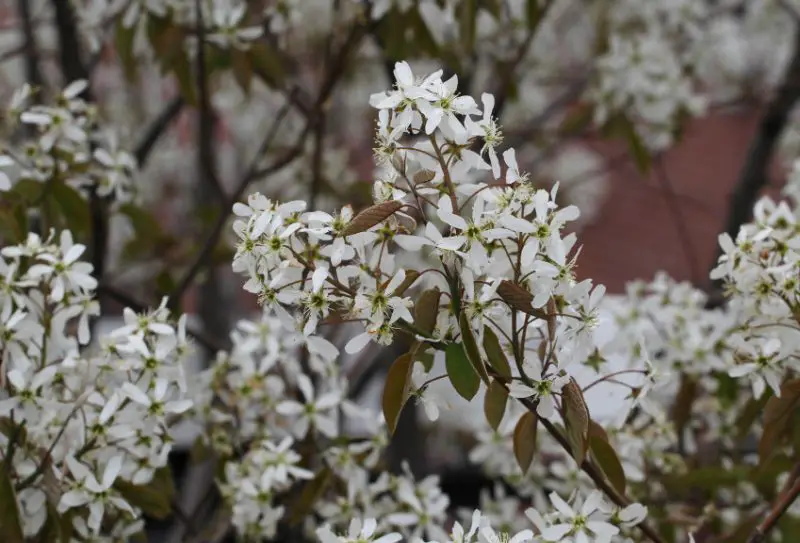
The Allegheny serviceberry (Amelanchier laevis) is a deciduous tree cherished for its exquisite white flowers and edible berries. With purplish-bronze leaves and blue-black berries, it offers four-season allure.
Native to North America, it thrives in various soils and environments, making it suitable for specimen planting, hedges, and native gardens. It reaches 15 to 25 ft. tall and wide, ideal for USDA Hardiness Zones 4 to 9, enjoying full sun to partial shade.
Shadblow Serviceberry Tree
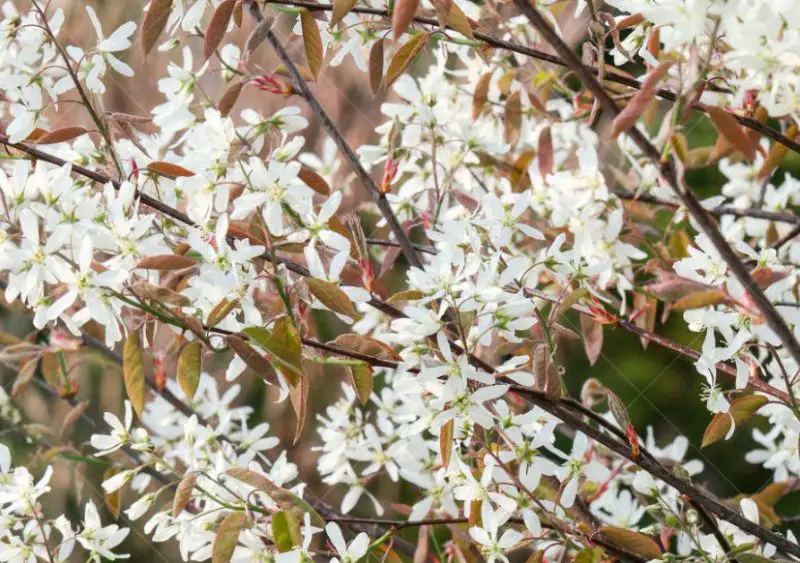
The shadblow serviceberry tree, also known as Canadian serviceberry, has clusters of white flowers blooming in March and April. Its fragrant blossoms, emerging from pink buds, form star-shaped petals.
With smooth bark and finely-toothed leaves, it thrives in partial shade and moist soil. Perfect for USDA Hardiness Zones 3 to 8, it reaches 15 to 25 ft. tall and up to 20 ft. wide, offering a delightful addition to any landscape.
Angel’s Trumpet
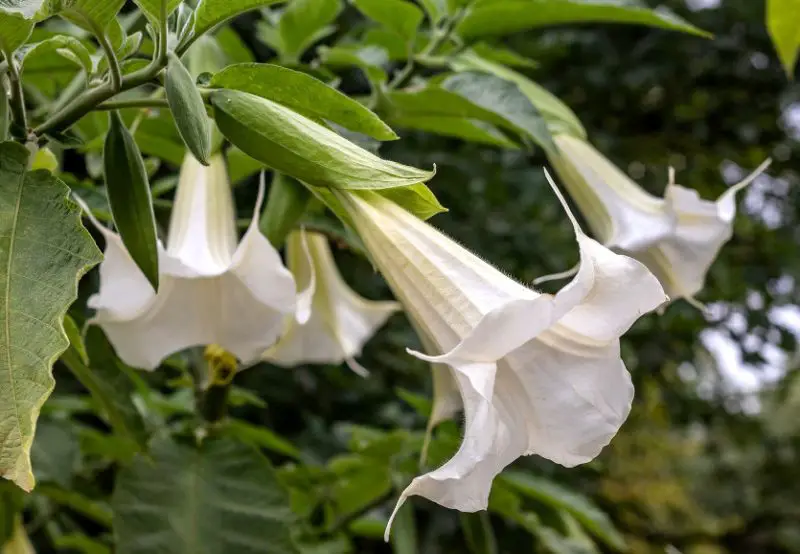
The Angel’s Trumpet tree is distinguished by its large, trumpet-shaped white flowers that bloom from summer to fall. With mid-green leaves and a vase shape, it adds an exotic touch to landscapes in warm climates.
However, note that all parts of the tree are toxic if ingested. Ideal for USDA Hardiness Zones 9 to 11, it reaches 3 to 8 ft. tall and 2 to 4 ft. wide.
American Yellowwood
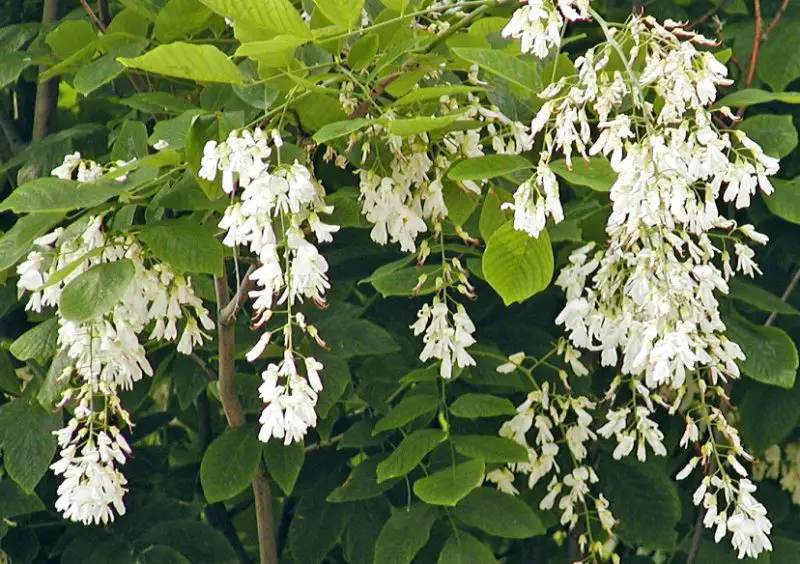
The American yellowwood is recognized by its clusters of fragrant, white pea-like flowers that hang in drooping clusters. With yellowish-green leaves turning bright yellow in fall, it’s an attractive addition to landscapes.
Ideal for USDA Hardiness Zones 4 to 8, it grows 30 to 50 ft. tall and 40 to 55 ft. wide, thriving in full sun.
Japanese Stewartia
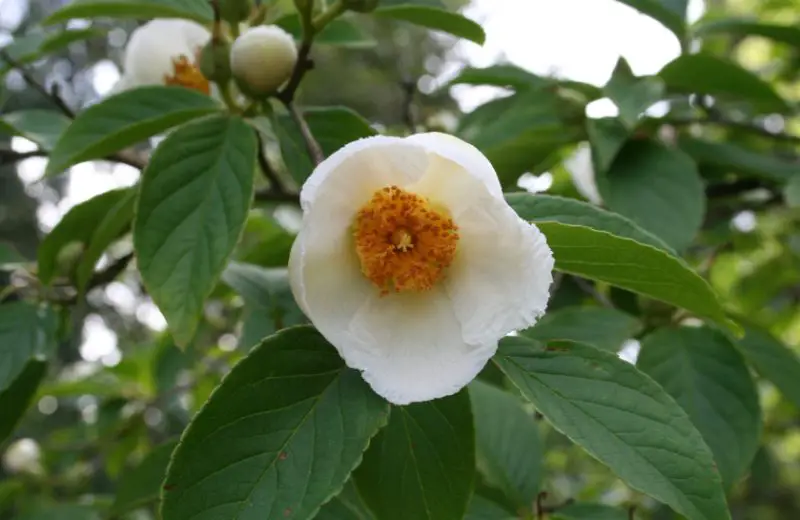
The Japanese Stewartia, or false camellia, is distinguished by its striking white camellia-like flowers with yellow centers blooming in late spring to early summer. Its dark green leaves turn vibrant shades of orange, red, and purple in the fall, enhancing its beauty.
Thriving in well-drained, acidic soil and preferring partial shade to full sun, the tree is ideal as a specimen or in groups for a striking effect. It typically reaches a mature size of 20 to 40 feet (6 to 12 meters) tall and wide and is suited for USDA hardiness zones 5 to 8.
Sourwood tree
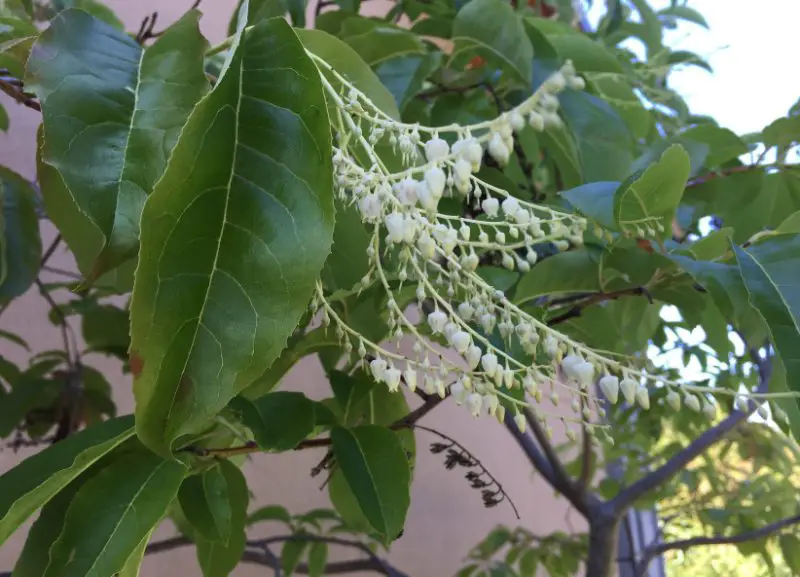
The sourwood tree is distinguished by its slow growth and clusters of fragrant, urn-shaped white flowers blooming in late spring and early summer. Its foliage turns vibrant shades of red, orange, or purple in the fall.
Thriving in acidic, well-drained soils, the tree is perfect as a specimen, lawn, or patio tree in areas with full sun or partial shade. It typically reaches a mature height and width of 20 to 30 feet (6 to 9 meters) and is suited for USDA hardiness zones 5 to 9.
Tree Hydrangea
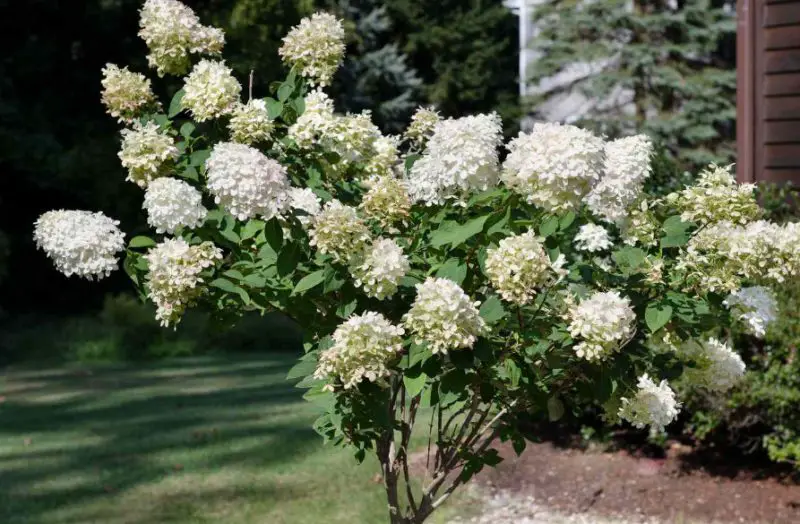
The tree hydrangea, specifically the Hydrangea paniculata ‘Grandiflora’ cultivar, is distinguished by its large cone-like clusters of white flowers that bloom from summer through fall. Its dark green leaves provide a striking backdrop for the abundant white blooms.
Thriving in well-drained soil, it’s suitable for various landscape uses, including hedges, foundation plantings, or as a focal point. Its mature size spans 10 to 25 feet (3 to 7.5 meters) tall and wide, suitable for USDA hardiness zones 3 to 9. It thrives in full sun to partial shade.
White Frangipani Tree
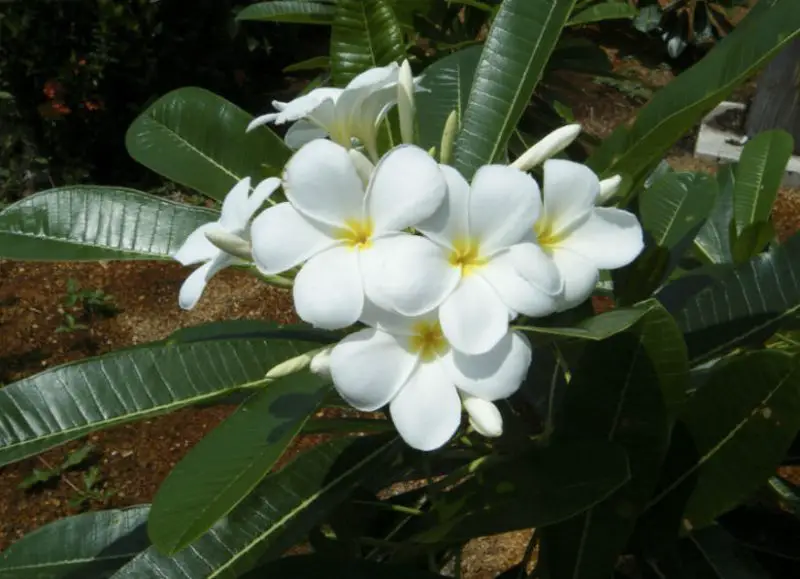
The white frangipani tree, scientifically labeled Plumeria obtusa, stands out with its tropical origins and aromatic white flowers, featuring spoon-shaped petals with a yellow base that contrast beautifully with the glossy dark green leaves.
Flourishing in tropical climates, it’s perfect for coastal gardens and patio settings, thriving under full sun exposure. Its mature height ranges from 10 to 25 feet (3 to 7.5 meters), suitable for USDA hardiness zones 10 to 12.
White Eastern Redbud
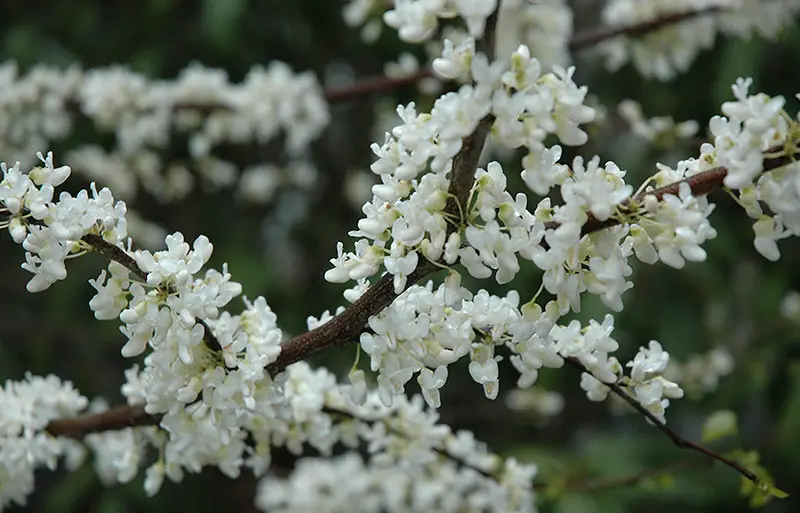
The white eastern redbud, scientifically termed Cercis canadensis alba, has an early spring bloom of white pea-like flowers. Its heart-shaped leaves transition from green to yellowish-green in fall.
Thriving in various soils, it flourishes as a specimen or shrub border plant, attracting pollinators in full sun or partial shade. With a mature height and width ranging from 20 to 30 feet (6 to 9 meters), it comfortably fits into landscapes within USDA hardiness zones 4 to 9.
Loblolly Bay
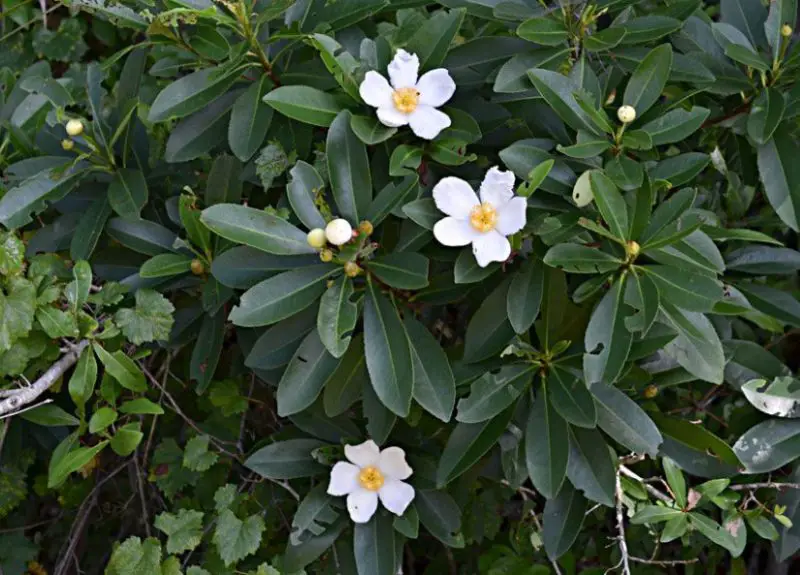
The loblolly bay, scientifically named Gordonia lasianthus, stands out with its fragrant white cup-shaped flowers and glossy dark green leaves. Flourishing in moist, acidic soils, it’s ideal for wetland and stream edges. With proper care, including regular watering, it thrives as a specimen or group planting in gardens.
The loblolly bay tree typically reaches heights of 30 to 60 feet (9 to 18 meters) and spreads 10 to 15 feet (3 to 4.5 meters) wide. It thrives in USDA hardiness zones 7 to 9 and prefers full sun or partial shade.
White Orchid Tree
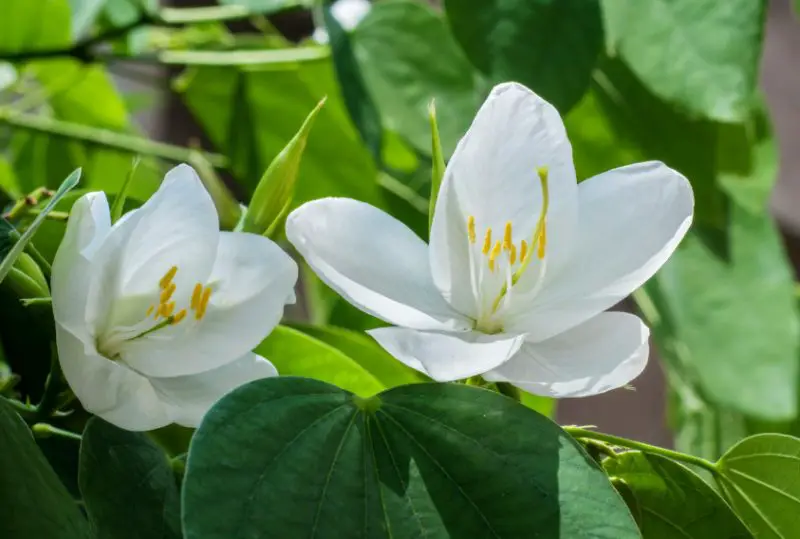
The white orchid tree, or Bauhinia, graces gardens with its orchid-like white flowers in spring and summer. Its distinctive heart-shaped leaves and long, flat brown seed pods add to its allure.
This medium-sized tree prefers sunny spots and well-drained soil, thriving in USDA hardiness zones 9 to 11.
White Wisteria
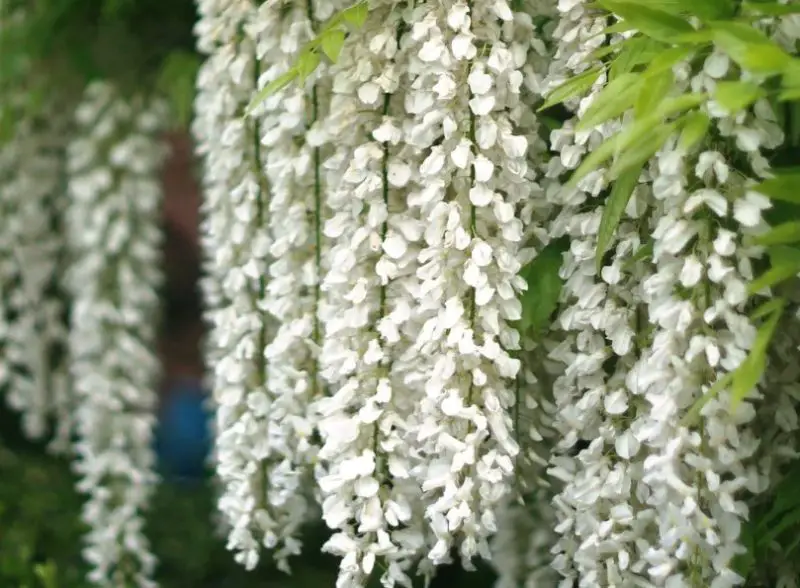
White wisteria trees, including Wisteria sinensis ‘Jako’ and Wisteria floribunda ‘Alba,’ are known for their cascading clusters of white racemes, up to 24″ (60 cm) long. These floral displays grace the tree for weeks in late spring or early summer, followed by long bean pods.
Thriving in full sun to partial shade and preferring moist, well-drained soil, these white wisteria trees can reach heights of up to 30 ft. (9 m). They are suitable for USDA Hardiness Zones 5 to 9.
White Flowering Chaste Tree
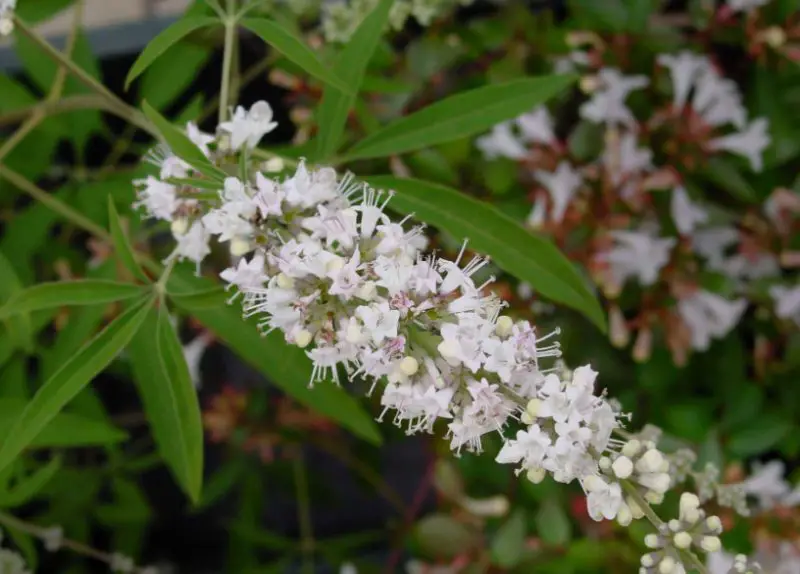
The white flowering ‘Alba’ chaste tree, scientifically known as Vitex agnus-castus, is a large multi-stemmed shrub or small tree that blooms in summer with attractive white panicles emitting a peppery scent.
With palmate compound leaves, this tree is ideal for cottage gardens, specimen trees, or lining driveways. The mature size of the ‘Alba’ chaste tree is 10 – 15 ft. (3 – 4.5 m) in height with a spread of 15 – 20 ft. (4.5 – 6 m). It thrives in USDA Hardiness Zones 7 to 9 and requires full sun exposure.
Two-Wing Silver Bell
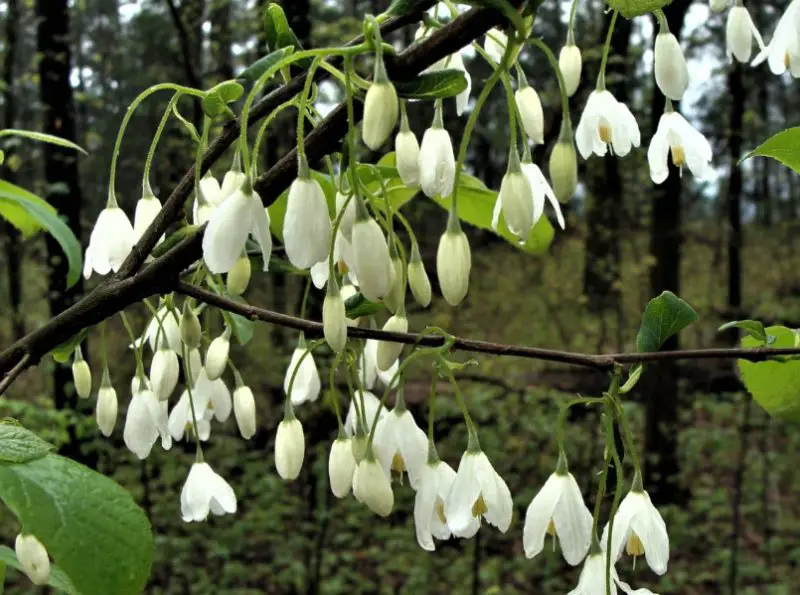
The two-wing silver bell, native to Texas, is a picturesque tree adorned with drooping white flowers in early spring. Its foliage, comprising long green oval leaves, transitions to a vibrant yellow in autumn.
Ideal for full sun and well-drained soil, the two-wing silver bell tree adds charm as a specimen or border plant. It typically reaches a mature height of 20 to 30 feet (6 – 9 meters) and thrives in USDA Hardiness Zones 5 to 8.
White Jacaranda

The white jacaranda (Jacaranda mimosifolia Alba) is a stunning deciduous tropical tree, renowned for its clusters of white trumpet-shaped flowers blooming from April to August.
It thrives in full sun and well-drained loamy soil, reaching a mature size of 25 to 40 ft. (7.6 – 12 m) tall with a spread of 45 to 60 ft. (13.7 – 18 m). Ideal for USDA Hardiness Zones 10 to 11.
Manna Ash
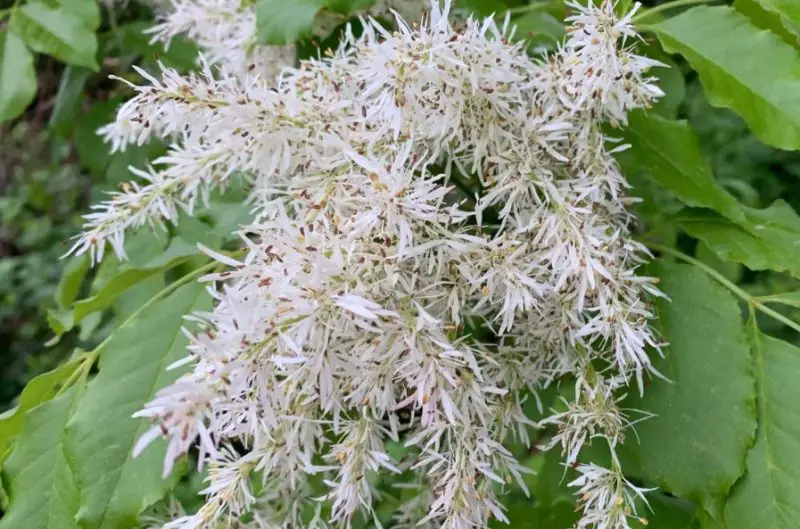
The Manna ash (Fraxinus ornus) is a medium-sized deciduous tree known for its dense clusters of fragrant white flowers in late spring. Its lush green foliage and smooth silvery bark add to its appeal.
Ideal for ornamental use in moist, organically rich, well-drained soil and full sun. It typically reaches a mature height of 40–50 ft. (12 – 25 m) and is suitable for USDA Hardiness Zones 5 to 6.
White Flowering Crape Myrtle Tree

The White Flowering Crape Myrtle Tree (Lagerstroemia indica) is a striking addition to landscapes, boasting cone-shaped clusters of white, crape-paper-like flowers that bloom repeatedly during summer. Against their dark green leaves, these flowers offer a stunning contrast.
Thriving in well-drained, average soil with medium moisture, they grow 5 to 25 ft. tall and flourish in USDA Hardiness Zones 6 to 9, requiring full sun exposure for optimal growth.
Japanese Crape Myrtle
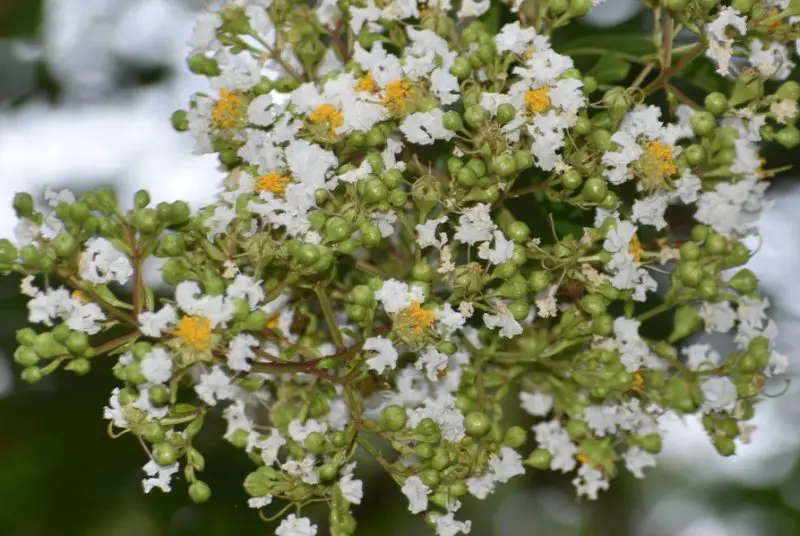
The Japanese Crape Myrtle (Lagerstroemia subcostata var. fauriei) is an elegant multi-trunk tree renowned for its stunning white flowers. Its abundant clusters of crape-like blooms adorn cone-like panicles, adding color and fragrance to summer gardens.
With leathery leaves turning golden yellow in fall, it thrives in sunny, well-drained sites, reaching 20 to 30 ft. tall and wide in USDA Hardiness Zones 6 to 9, requiring full sun exposure.
Bigleaf Magnolia Tree
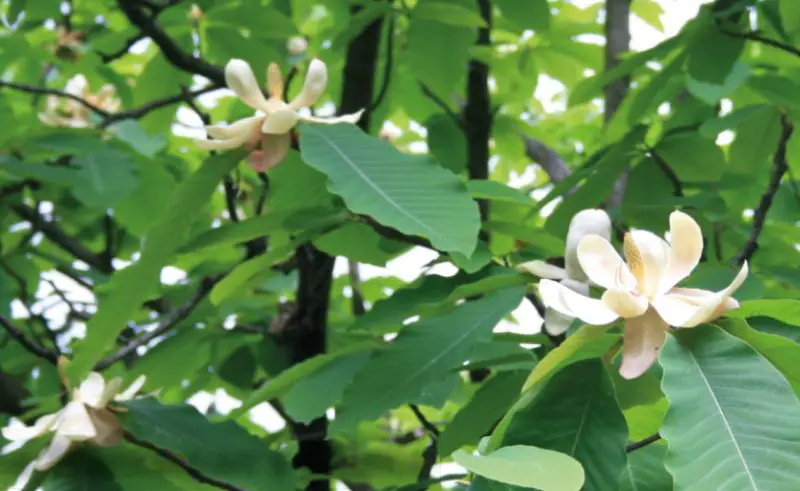
The Bigleaf Magnolia Tree (Magnolia macrophylla) is distinguished by its large, broad leaves and striking star-shaped creamy-white fragrant flowers. Notably, its blossoms feature lance-shaped white petals with a rose-purple base.
Thriving in North America, it prefers organically rich, well-drained soils and grows 30 to 40 ft. tall and wide in USDA Hardiness Zones 6 to 9, thriving in full sun or partial shade.
Southern Magnolia

The Southern Magnolia (Magnolia grandiflora) stands out with its dense evergreen foliage, large white cup-shaped aromatic flowers, and cone-like red-seeded pods. Its thick, leathery leaves and rounded crown make it a majestic shade tree in southern landscapes.
Thriving in neutral to rich, well-drained soils, it tolerates various conditions but prefers warmth. Growing 60 to 80 ft. tall and 30 to 50 ft. wide, it’s ideal for USDA Hardiness Zones 7 to 10, requiring full sun or partial shade.
Star Magnolia
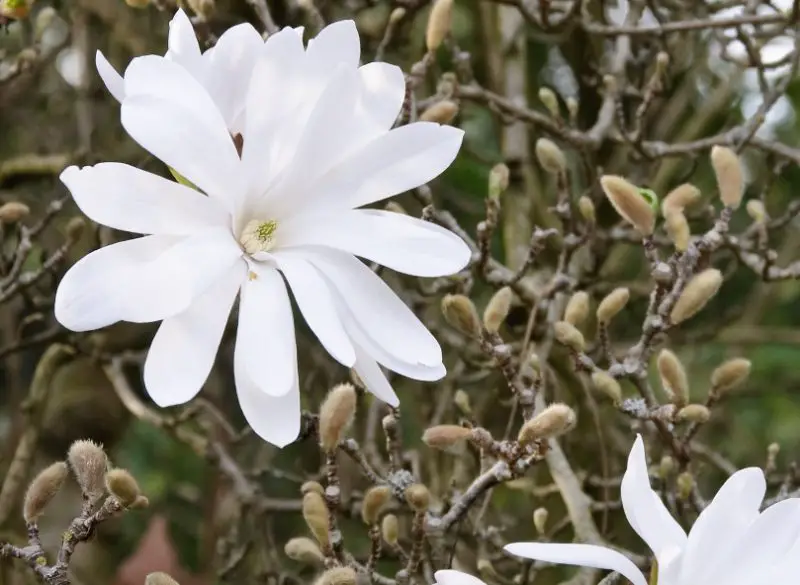
The Star Magnolia (Magnolia stellata) is prized for its stunning, star-shaped, fragrant white flowers, each with slender, delicate petals. Blooming early in spring, they contrast beautifully with their dark green foliage.
Thriving in well-drained, slightly acidic soil, it grows 10 to 20 ft. tall and 8 to 10 ft. wide in USDA Hardiness Zones 4 to 9, requiring full sun or partial shade.
Sweetbay Magnolia
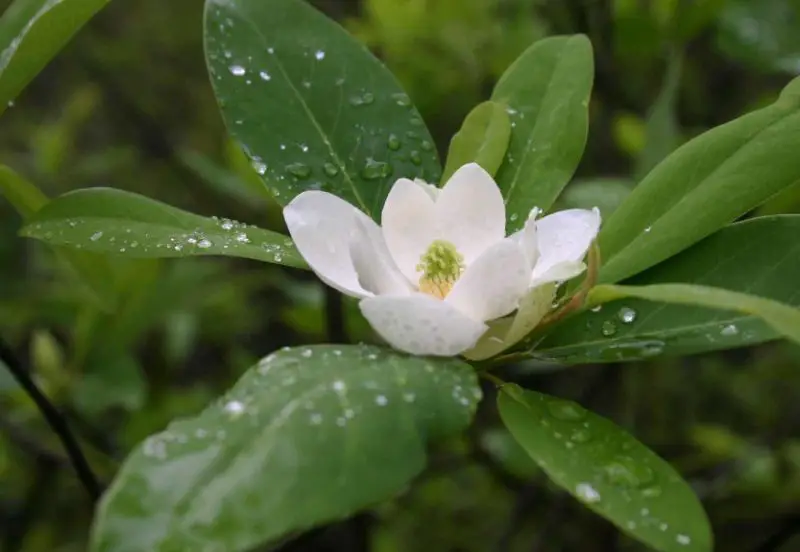
The Sweetbay Magnolia (Magnolia virginiana) boasts cup-shaped creamy-white flowers blooming from May to June, emitting a fragrant scent. With glossy lanceolate leaves, it forms a rounded to pyramidal crown.
It thrives as an evergreen in the South and deciduous in colder climates, growing 10-35 ft. tall and wide in USDA Hardiness Zones 5-10, tolerating various soils and ideal for lawn specimens or foundation plantings.
English Hawthorn

The English Hawthorn (Crataegus laevigata) is prized for its clusters of white five-petalled flowers in spring, emitting a sweet fragrance. With shiny green leaves, large thorns, and red fall fruits, it creates a stunning display.
Hardy and adaptable, it thrives in various soils, ideal for security hedges or specimens. Tolerant of salty air, it suits coastal landscapes.
Flowering Cherry Tree
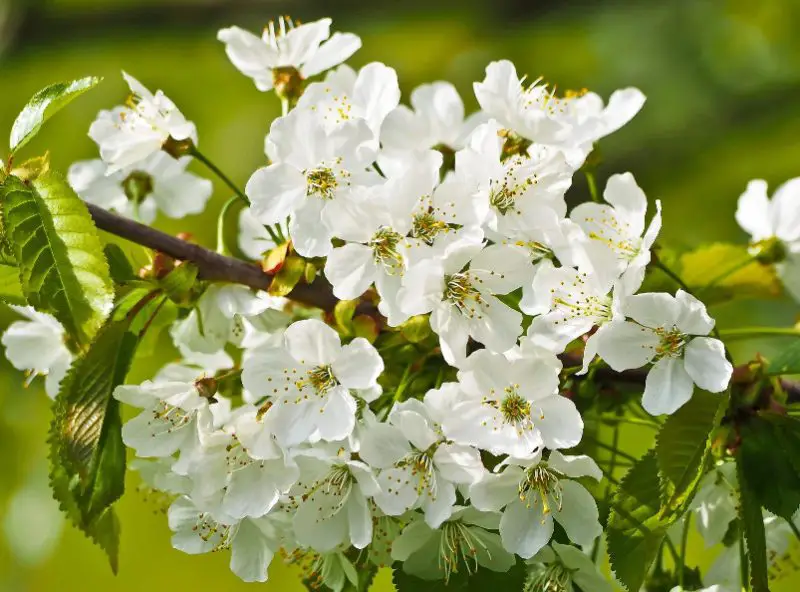
Flowering Cherry Trees (Prunus serrulata) are renowned for their abundant display of fragrant white blossoms, adorning vase-shaped spreading crowns in spring. Their double blooms offer a striking contrast against dark green foliage.
These trees prefer well-drained, fertile soil and full sunlight, thriving as specimens or in groups. Varieties include ‘Shirotae,’ ‘Shogestu,’ ‘Snow Fountains,’ and ‘Tai-Haku,’ each offering unique characteristics. Suitable for USDA Hardiness Zones 5-8, they reach 15-20 ft. tall and wide, providing beautiful fall foliage.
Yoshino Cherry
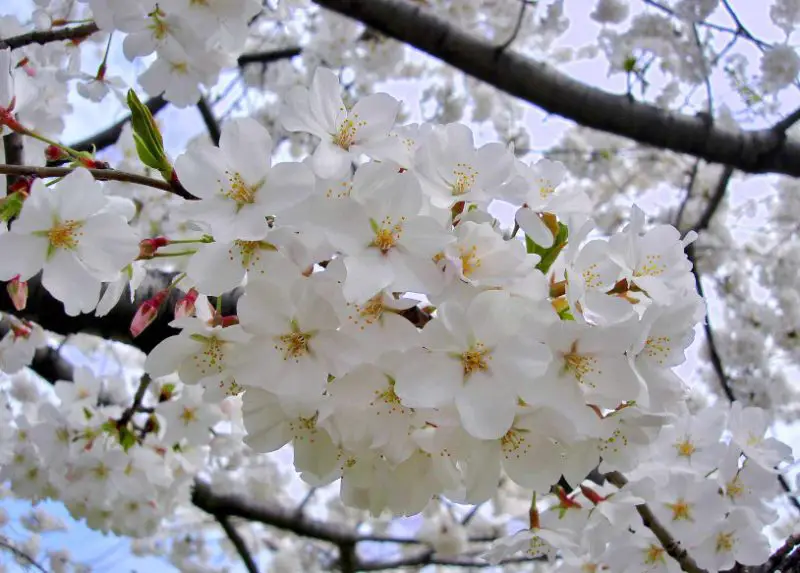
Yoshino Cherry (Prunus x yedoensis) trees showcase stunning white-pink blossoms in early spring, forming a breathtaking floral spectacle. They feature dark green leaves and transition to vibrant reds, oranges, and yellows in fall, with small black ornamental fruits.
Ideal for landscapes, these trees have an upright, spreading habit and thrive in well-drained soils with at least four hours of sunlight daily. They reach 20-30 ft. tall and wide, suitable for USDA Hardiness Zones 5-8, and prefer full sun or partial shade.






